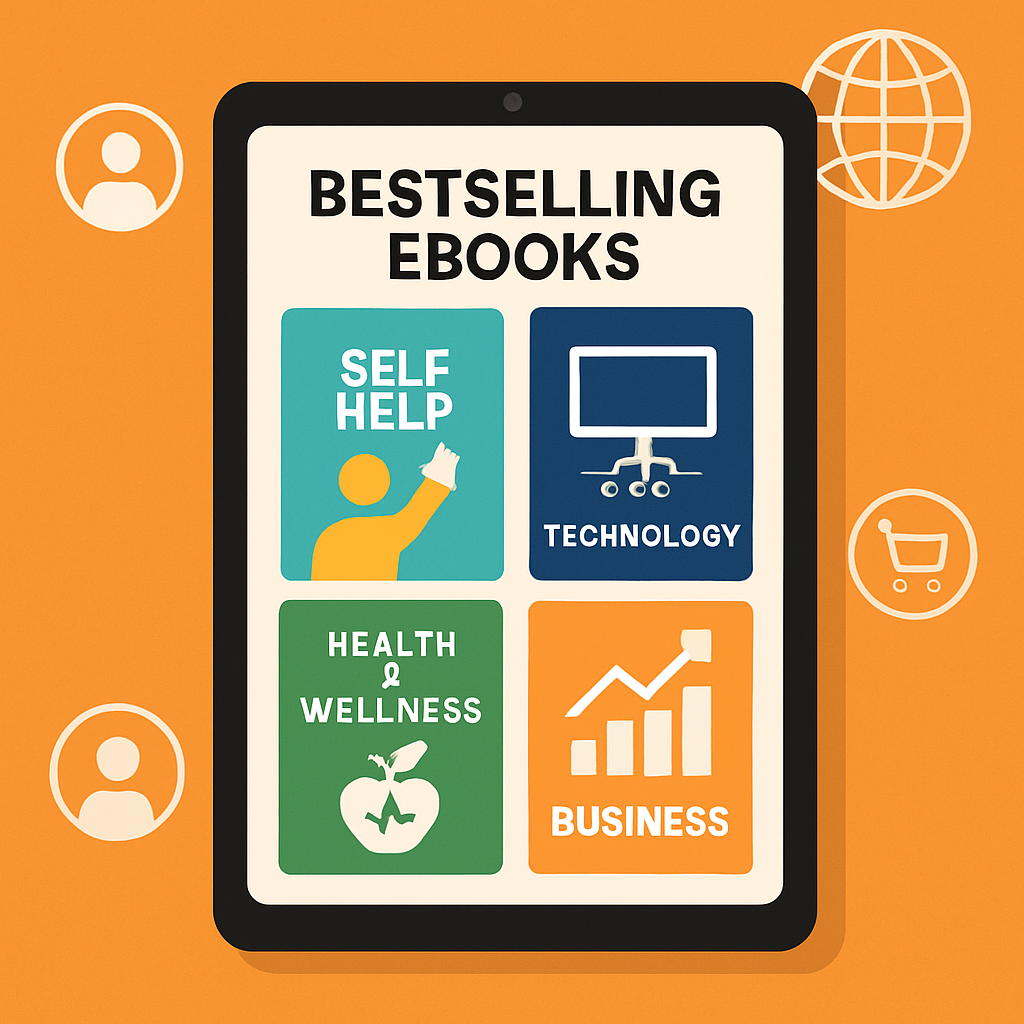The ebook industry continues to burgeon, presenting an unprecedented opportunity for creators and authors to monetize their expertise globally. In a world leaning ever more digital, the ability to package knowledge in a portable, accessible, and affordable format fuels a booming marketplace expected to soar in value. In 2022 alone, the global ebook market was valued at approximately $19.95 billion, with projections forecasting a climb to $32.19 billion by 2032. This growth signals not just sustained interest but transformational changes in readers’ consumption habits, making 2025 a prime year to leverage ebooks as profitable digital assets.
What sets ebooks apart is their flexibility and global accessibility. Unlike traditional print books, ebooks circumvent physical distribution hurdles, allowing instant downloads and access from virtually anywhere. Readers relish the convenience of carrying entire libraries on devices like Amazon Kindle, tablets, or smartphones — underscoring immense demand. Meanwhile, authors benefit from lower production costs, no shipping, and the potential for recurring revenue streams, all contributing to a favorable ecosystem for ebook success.
To capitalize on this dynamic market, understanding how to strategically write, publish, and market ebooks will be essential. From discovering high-demand niches to selecting the right publishing platform, each step influences your earning potential. Notably, the expanding landscape of ebook publishing platforms such as Amazon Kindle, Smashwords, Kobo Writing Life, and Draft2Digital offers diverse avenues to reach readers worldwide. Coupled with marketing automation tools and affiliate networks, these platforms empower authors to not only publish but also build lasting connections with their audiences.
This article delves into the core facets of successfully making money with your ebook in 2025. By dissecting market trends, detailing step-by-step creation processes, and exploring the most effective distribution and promotional channels, it provides a comprehensive guide tailored for creators aiming to transform their passion into profit. It’s not merely about writing an ebook but mastering the art of presenting it compellingly and leveraging technological advancements to maximize reach and returns.
With a tapestry of opportunities ahead, your knowledge holds the potential to become a lucrative asset. The journey from manuscript to monetization involves careful planning and savvy execution, but with the right insights and strategies shared here, your ebook can rise above the noise and become a revered resource — rewarding both intellectually and financially.
Choosing Profitable Niches and Understanding Ebook Market Demand in 2025
Navigating the ebook market successfully starts with selecting a niche that not only aligns with your expertise but also meets readers’ current interests and needs. The golden rule, “write what you know,” remains crucial because passion and knowledge underpin credible, engaging content. However, beyond personal interest, pinpointing the right niche necessitates thorough market analysis to ensure demand and profitability.
One effective approach to unearthing profitable ebook niches involves leveraging social listening tools and trend analysis platforms like Google Trends, social media polls, and specialized market research. For example, keywords around self-help, technology advancements like AI, health and wellness, and personal finance continue to generate massive interest. These areas appeal to broad audiences eager for actionable insights, offering fertile ground for ebook topics.
Furthermore, competitive analysis enhances niche selection by observing what successful authors produce. Platforms such as Amazon Kindle and Smashwords allow rapid insight into what sells and reader feedback. Monitoring bestselling titles and reviews provides clues about gaps in the market or subtopics underserved by existing works — a tactical advantage for positioning your ebook effectively.
Understanding your target audience’s demographics also defines the direction your niche takes. Are your readers millennials fascinated by startup culture or perhaps retirees seeking guides on personal growth? Knowing this facilitates crafting content that resonates and drives sales.
Here is a list of Practical Steps to Identify a Profitable Niche in 2025:
- Use Google Trends to spot rising topic popularity.
- Analyze Amazon Kindle’s bestseller lists in relevant categories.
- Survey potential readers via social media or email lists.
- Evaluate the competition for saturation and content gaps.
- Check demand consistency through search engine and marketplace data.
| Aspect | Purpose | Tools/Examples |
|---|---|---|
| Trend Analysis | Identify rising topics over time | Google Trends, social media hashtags |
| Competitive Analysis | Understand market saturation and gaps | Amazon Kindle, Smashwords bestseller charts |
| Audience Research | Define demographic and psychographic traits | Polls, surveys, social media analytics |
| Content Gap Identification | Spot unaddressed reader needs | Reader reviews, forum discussions |
| Demand Validation | Ensure enough audience interest | Search volume tools, marketplace sales data |
Additionally, the increased convergence between ebook content and complementary digital products is a trend worth noting. Many authors expand into platforms like Teachable or Udemy to create courses complementing their ebooks, offering bundled solutions that enhance value and scaling potential. Exploring cross-platform synergies can amplify your revenue streams and strengthen your brand.

Crafting, Formatting, and Publishing Your Ebook for Maximum Reach
Creating a successful ebook that sells requires meticulous attention to content quality, design, and technical formatting. A well-written ebook with a captivating cover and seamless readability landscape attracts more buyers and receives favorable reviews, boosting visibility on crowded platforms.
The creative process begins with comprehensive research. Even if you’re an expert, diving deep into the latest studies, trends, and data ensures your content is current and trustworthy. Incorporating engaging elements such as case studies, infographics, and real-life examples enriches reader experience. Authenticity and originality differentiate your ebook by adding your unique voice and perspective to the topic.
Next, organizing your content with a clear outline improves flow and coherence. Start with a compelling introduction that outlines what readers will gain, followed by chapters focused on specific subtopics. Including practical tips, exercises, and summaries enhances comprehension and retention.
Design also plays a critical role. Developing an eye-catching cover using tools or professional designers can directly influence purchase decisions. Your cover should clearly convey the ebook’s theme while appealing aesthetically to your target demographic’s preferences. Consistent typography and color palettes create a cohesive look that aligns with your author brand. A well-executed cover is often the difference between a browser and a buyer. For insights on creating striking designs, see dedicated resources on eye-catching ebook covers.
Formatting tailored to the specific publishing platform enhances the reader’s experience and streamlines the publishing process. For example:
- Amazon Kindle uses AZW3 and MOBI formats;
- Apple Books and Kobo Writing Life prefer EPUB;
- Draft2Digital offers automated conversion to multiple formats.
Moreover, accessibility features such as alt text for images ensure inclusivity and may improve rankings on certain platforms. Be sure to optimize image resolution to balance quality and file size, avoiding slow downloads that frustrate readers.
Once creation and formatting are complete, choosing a publishing platform is paramount. Amazon Kindle remains the market leader, offering extensive reach and up to 70% royalties. However, platforms like Smashwords, IngramSpark, Draft2Digital, Rakuten Kobo, Gumroad, and Sellfy provide different benefits ranging from broader distribution to customizable storefronts and reduced fees. Selecting the right platform may involve weighing factors such as:
- Royalty rates and fees;
- Content exclusivity requirements;
- Ease of use and support;
- Marketing tools integration;
- Audience demographics.
| Publishing Platform | Key Features | Royalty/Fees | Distribution Reach |
|---|---|---|---|
| Amazon Kindle | Largest audience, easy-to-use tools, Kindle Unlimited program | 35%-70% royalties, exclusivity optional | Worldwide, Amazon ecosystem |
| Smashwords | Multi-platform distribution, free ISBN, dashboard analytics | Author receives 60%-85%, Smashwords takes ~15% | Apple Books, Barnes & Noble, Kobo, libraries |
| Kobo Writing Life | User-friendly interface, 70% royalties, offers promotional tools | 70% royalties, minimum pricing restrictions | Strong presence in Canada, Europe, US |
| Draft2Digital | Automated format conversion, wide distribution, sales tracking | 10% fee on retail price | Amazon, Kobo, Apple Books, Barnes & Noble |
| Gumroad | Custom storefronts, no monthly fees, marketing integrations | 10% transaction fee + payment processor fees | Global audience |
| Sellfy | Built-in ecommerce tools, upsells, email marketing | Monthly plans from $22/mo, additional fees for higher sales volumes | Direct sales via own links |
Ensuring you optimize your ebook for the chosen platform’s formatting requirements not only smoothes the uploading process but maximizes compatibility with readers’ devices. For instance, Amazon KDP’s previewer tool helps authors verify how their ebook will display on various Kindle models, preventing embarrassing formatting issues that could deter buyers.
Effective Marketing Strategies to Maximize Ebook Sales in 2025
Publishing your ebook is just the starting point — active and thoughtful marketing underpins true sales success. Building visibility in a competitive landscape requires a mix of organic and paid approaches tailored to your target audience.
A foundation of effective marketing lies in creating an authoritative online presence. Launch a dedicated author website or landing page, where visitors can learn about your ebook’s value proposition and purchase easily. Platforms like GetResponse can help set up ebook stores and automate email campaigns, enabling you to build your audience without transaction fees. For deeper insights, consult resources on author branding and ebook marketing to refine your approach.
Social media channels are indispensable for connecting with readers directly. Platforms such as Instagram, TikTok — especially via #booktok — and Twitter foster communities where you can engage audiences through live sessions, giveaways, and sneak peeks. Collaboration with influencers or book bloggers multiplies your reach significantly.
Paid advertising enhances your ebook’s discoverability dramatically. For example, running sponsored ads on Amazon targets interested buyers precisely on the platform where they shop. Similarly, Facebook and Instagram ads allow hyper-targeted campaigns based on interests and demographics.
Email marketing remains one of the most powerful tools to nurture leads and convert curiosity into purchases. Growing an email list through lead magnets, such as exclusive chapters or discount offers, keeps readers connected and opens channels for future product promotions. Tools like GetResponse enable seamless management of these campaigns and automation of reader outreach.
Here is a list of proven marketing tactics for ebook sales:
- Build an attractive, user-friendly landing page.
- Engage your community on social media with interactive content.
- Leverage paid ads on Amazon, Facebook, and Instagram.
- Run promotional events such as giveaways or launch discounts.
- Collaborate with influencers and book review bloggers.
- Use email marketing campaigns with targeted newsletters.
| Marketing Channel | Strengths | Best For |
|---|---|---|
| Author Website/Landing Pages | Centralized ebook sales, brand control | Long-term sales & building email list |
| Social Media Platforms | Direct engagement, viral potential | Community building and brand awareness |
| Paid Advertising | Highly targeted reach, scalable | Increasing immediate sales and visibility |
| Email Marketing | Personalized communication, high conversion | Reader retention and upselling |
| Influencer Collaborations | Credibility boost, organic reach | New audience acquisition |
Combining multiple channels and consistent activity typically yields the best results. Authors who integrate their marketing channels, for instance linking social media to landing pages and email signups, develop loyal followings and maximize their ebook revenue potential. For comprehensive strategies, explore guides on ebook marketing techniques and how to promote your ebook online.
Leveraging Affiliate Marketing and Monetization Beyond Ebook Sales
In 2025, maximizing revenue from your ebook focuses not only on direct sales but on ancillary monetization channels. Affiliate marketing, in particular, has emerged as a powerful strategy for authors to augment their earnings while providing value to readers.
Affiliate marketing involves partnering with companies to recommend products or services relevant to your ebook’s topic, earning commissions on sales generated through your referral links. For example, if your ebook centers on digital marketing, linking to platforms like Udemy for relevant courses or tools like GetResponse can be lucrative. Integrating affiliate offers tactfully within your ebook content, website, or email sequences benefits both your audience and your bottom line.
Beyond affiliate programs, many authors diversify by creating bundled products, such as exclusive webinars on Teachable or coaching sessions promoted via Patreon. These avenues create premium experiences that reinforce your ebook’s content while generating recurring income.
Several ebook authors also add value by hosting live events or participating in online educational platforms, including Udemy or Teachable, which provide accessible routes for writers to scale their educational offerings and deepen audience engagement. Such diversification safeguards against fluctuating ebook sales and builds lasting relationships with readers.
Key steps to harness affiliate marketing for your ebook success:
- Identify affiliate programs aligned with your ebook theme.
- Incorporate affiliate links meaningfully and transparently.
- Leverage email marketing to nurture affiliate-driven campaigns.
- Use analytics to track performance and optimize conversions.
- Combine affiliate promotions with other monetization products like courses or memberships.
| Monetization Strategy | Application | Platforms/Examples |
|---|---|---|
| Affiliate Marketing | Recommend relevant services/products within ebook or related content | Amazon Kindle Affiliate, Udemy, GetResponse |
| Membership Programs | Exclusive content and community through subscriptions | Patreon, Sellfy Membership integrations |
| Online Courses | Expand on ebook topics with video tutorials | Teachable, Udemy |
| Coaching & Consulting | Personalized help tied to ebook insights | Patreon, private sessions booking |
| Webinars and Workshops | Live interactions and learning sessions | GetResponse webinars, integrated marketing |
For authors exploring this integrated approach, understanding how to blend ebook sales with affiliate and digital product marketing is essential. Thoroughly guiding your readers to additional offerings increases lifetime customer value and strengthens your overall brand presence. Learn how to create compelling ebook content that drives affiliate success at compelling ebook content and implement a winning affiliate strategy via proven tactics.
Tracking Ebook Sales Performance and Iterating for Growth
To prosper continuously, an ebook author must track sales performance and understand their audience’s buying behaviors. Analytics-informed decisions enable strategic adjustments that improve earnings over time.
Most publishing platforms and ebook distributors provide detailed dashboards showing sales, royalties, geographical data, and reader feedback. For instance, Amazon KDP’s dashboard offers insights into unit sales, bestseller rankings, and promotion effectiveness. Likewise, Draft2Digital and Smashwords aggregate data across multiple storefronts, giving authors a comprehensive view of performance.
Following metrics are critical for ebook business refinement:
- Units sold over time and during promotions;
- Conversion rates at various price points;
- Reader reviews and ratings for quality insights;
- Geographical distribution to tailor marketing campaigns;
- Affiliate link performance for additional revenue streams.
Regularly reviewing these analytics provides actionable intelligence. For example, if certain promotional channels underperform, shifting budget or tactics to higher-converting platforms makes financial sense. If reader reviews indicate specific content gaps or suggestions, updating your ebook or creating complementary products responds to market demand and enhances reputation.
Iterative improvement applies not just to content but also to pricing strategies. Testing various price points during seasonal sales or via platform promotions can identify sweet spots for maximizing revenue without sacrificing reader acquisition. For nuanced pricing insights, visit how to price your ebook for profit.
| Performance Metric | Purpose | Recommended Action |
|---|---|---|
| Sales Volume | Measure overall demand | Boost marketing during low sales periods |
| Reader Ratings & Reviews | Gauge content satisfaction | Incorporate feedback into revisions |
| Geographic Insights | Identify target regions | Run localized ads or content adaptations |
| Promotion Effectiveness | Evaluate marketing ROI | Shift resources to high-converting campaigns |
| Affiliate Link Performance | Monitor secondary revenue streams | Optimize placements and messaging |
Ultimately, a vigilant approach to analytics combined with creativity in marketing and product development will keep your ebook business vibrant and financially rewarding. Maintaining this data-driven mindset fosters growth in the ever-evolving ebook space and helps authors stay ahead of market shifts.

Frequently Asked Questions About Earning with Ebooks in 2025
- Is it still profitable to write and sell ebooks in 2025?
Yes, the ebook market is expanding globally with increasing reader demand and technological advancements facilitating easier creation and distribution. With proper niche selection and marketing, ebooks remain a viable and profitable avenue. - Which platforms offer the best royalties for ebook sales?
Amazon Kindle offers up to 70% royalties, while Rakuten Kobo also provides 70% under specific pricing criteria. Other platforms like Draft2Digital take a 10% distribution fee but offer multi-storefront access. - Do I need an ISBN to publish my ebook?
ISBN requirements depend on your chosen publishing platform. Amazon uses ASINs allowing publication without ISBNs, but distributing widely across multiple stores often requires ISBNs, which typically incur fees unless provided free by national agencies. - How can I market my ebook effectively online?
Build a compelling author website, use social media interaction (notably TikTok’s #booktok), employ email marketing tools such as GetResponse, run sponsored ads, and collaborate with influencers to maximize visibility and sales. - Can I combine ebook sales with other digital products?
Definitely. Many authors bundle ebooks with online courses via Teachable or Udemy, or create membership content on Patreon and Sellfy, diversifying income streams and enhancing audience engagement.


